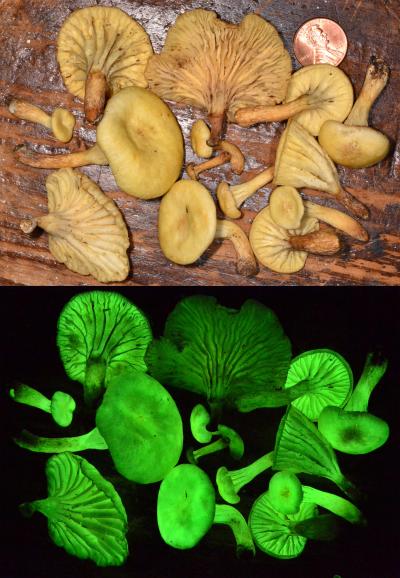Lost Glow-in-the-Dark 'Ghost Mushrooms' Rediscovered

In the lush forests of Brazil, researchers have found a glow-in-the-dark mushroom not seen since 1840. The long-forgotten fungus has been reclassified, but scientists are still trying to determine just what makes the mysterious mushroom glow — and why.
The mushroom's bioluminescence, or an organism's ability to produce light on their own, was first discovered by English botanist George Gardner, who spotted a group of boys playing with a glowing fungus on the streets of Vila de Natividade in Brazil. The boys led him to where it grew at the base of a decaying dwarf palm, and Gardner named it Agaricus gardneri.
The fungus wasn't seen again until 2009, when San Francisco State University researcher Dennis Desjardin and colleagues collected new specimens of the glowing mushroom and reclassified it as Neonothopanus gardneri. But tracking down the elusive fungus was no easy task.
Researchers had to "go out on new moon nights and stumble around in the forest, running into trees," while on the lookout for nearby poisonous snakes and prowling jaguars, Desjardin recalled. Technology has aided them in their hunt, with digital cameras allowing the researchers to photograph mushrooms in darkened rooms, since some bioluminescence is not visible to the human eye, and analyze the glow within a few minutes, compared to the 30 to 40 minutes required of regular film exposure.
As for what makes the mushroom shine, researchers believe that it makes light in the same way that a firefly does, through a chemical mix of a luciferin compound and a luciferase. Luciferase is an enzyme that aids the interaction among luciferin, oxygen and water to produce a new compound that emits light. However, scientists haven't yet identified luciferin and luciferase in fungi.
"They glow 24 hours a day, as long as water and oxygen are available," Desjardin said. "But animals only produce this light in spurts. This tells us that the chemical that is acted upon by the enzyme in mushrooms has to be readily available and abundant."
Scientists have discovered several other glow-in-the-dark mushroomsaround the world in recent years.
Get the world’s most fascinating discoveries delivered straight to your inbox.
There are about 65 luminescent fungi speciesknown. Scientists aren't sure why they glow, but the ability may have evolved to attract nocturnal animals to aid in dispersal of the fungi's spores — spreading their offspring around.
"We want to know how this happens, how it evolved, and if it evolved multiple times," Desjardin said. "Each one of these is a fascinating question that we are close to answering."
The findings are available online and are scheduled to be published in the November/December print issue of the journal Mycologia.
You can follow LiveScience writer Remy Melina on Twitter @remymelina. Follow LiveScience for the latest in science news and discoveries on Twitter @livescience and on Facebook.
